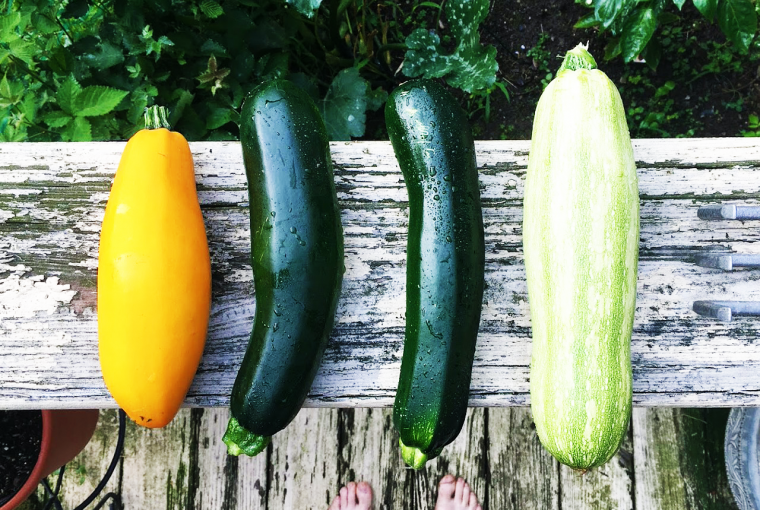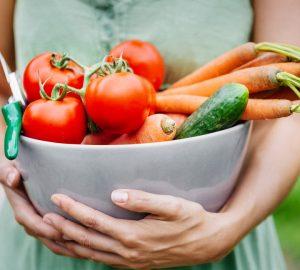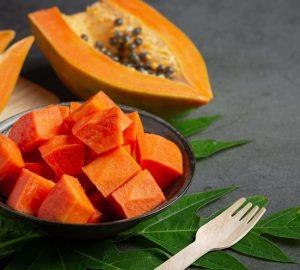If you’re looking to supercharge your diet, it might be time to reach for zucchini. The squash’s packed with essential nutrients, from disease-busting antioxidants to gut-friendly fiber. It’s also a versatile ingredient, thanks to its mild, delicate flavor that works well in savory entrées and sweet desserts alike. Need more deets before buying a bag full of ’em? Keep reading for zucchini’s nutrition, health benefits, and more (including a chef’s kiss-worthy zucchini bread recipe!).
What Is Zucchini?
An integral member of the gourd family, zucchini’s a variety of summer squash that counts beloved produce such as pumpkins, butternut squash, and melons as close relatives. The can be found in different colors (dark green, yellow, and pale green or nearly white), but the flavor and nutritional value of zucchini are similar across the board, according to the University of Illinois Extension. Oh, and get this: Botanically speaking, zucchini is a fruit — a berry, to be exact. However, it’s often prepared as a veggie (i.e. sautéed, roasted, steamed, grilled).
Zucchini Nutrition Facts
Both the flesh and peel of zucchini offer nutrients such as digestion-promoting fiber, bone-building calcium, mood-boosting magnesium, and muscle-helping potassium. The entire squash also offers disease-fighting antioxidants, including vitamin C and polyphenols. Even the edible seeds (which are soft and mild tasting) provide some nutrition by way of fiber, vitamin A, and vitamin C, according to registered dietitian Gina Holmes, M.S., R.D.N., L.D.
Here’s the nutritional profile of 1 cup sliced raw zucchini (~113 grams) according to the United States Department of Agriculture:
- 19 calories
- 1 gram protein
- < 1 gram fat
- 4 grams carbohydrate
- 1 gram fiber
- 3 grams sugar
Health Benefits of Zucchini
Reduces Risk of Chronic Disease
“Zucchini is chock full of health-protecting antioxidants, including beta-carotene, lutein, and zeaxanthin,” shares Trista Chan, R.D., M.H.Sc., registered dietitian and founder of The Good Life Dietitian. Collectively, these nutrients are known as carotenoids, antioxidant plant pigments that give the yellow, red, or orange color to the produce, according to Oregon State University. Both green and yellow zucchini have carotenoids, but the latter contains way more due to its yellow color, according to a 2017 study. And need not forget about the vitamin C in zucchini, which is also a powerhouse of an antioxidant, according to a 2021 article.
Reminder: Antioxidants, such as those in zucchini, destroy free radicals (harmful molecules that, in excess, can lead to oxidative stress, ultimately causing cell damage and increasing the risk of chronic diseases like cancer), says Chan. Eating a diet rich in antioxidants can help control free radicals, protect cells from oxidative stress, and thus stave off illness, according to the Academy of Nutrition and Dietetics.
Supports Healthy Digestion
“Zucchini is a great source of both soluble and insoluble fiber,” notes Holmes. Soluble fiber, in particular, is prebiotic, meaning it feeds good bacteria in your gut. This keeps them healthy, allowing them to regulate digestive functions such as nutrient absorption, according to a 2018 article. And as its name implies, soluble fiber is, well, soluble: It absorbs water in the GI tract, creating a gel-like substance that firms up stool and potential eases diarrhea. Meanwhile, insoluble fiber bulks up stool and encourages regular intestinal muscle movements, which can prevent constipation, notes Chan.
Regulates Blood Sugar
The fiber in zucchini can also help normalize your blood sugar levels. This is crucial because frequent blood sugar spikes can increase your risk of type 2 diabetes, according to Harvard T.H. Chan School of Public Health. Here’s how it works: The body can’t break down or absorb fiber, so it stays intact in the GI tract, helping slow down the absorption of sugar — and therefore, its release into the bloodstream — ultimately keeping blood levels from spiking, says Sarah Muhammad, R.D., registered dietitian and founder of Nutrition with Intention. A 2016 article also notes that fiber improves the secretion of insulin, the hormone crucial for maintaining healthy blood sugar levels.
Manages Blood Cholesterol
Once again, fiber is here to save the day. Fiber can encourage healthy cholesterol levels by reducing LDL (“bad”) cholesterol, says Muhammad. It basically acts like a broom as it sweeps LDL cholesterol from the blood and out of the body via stool, she says. This can help protect your heart, as high LDL cholesterol levels can increase your risk of stroke and heart disease, according to the Centers for Disease Control and Prevention.
Promotes Healthy Vision
Zucchini contains tons of vitamin A, a nutrient that’s important for your peepers. “Vitamin A helps support healthy vision by [protecting] eye tissue from sunlight deterioration and the natural aging process,” explains Holmes. Also, “it maintains the function of the photoreceptors within your eyes,” she adds. This is pretty darn important, considering photoreceptors are the cells in the eye that help you see by recognizing light and sending info to the brain, according to the American Academy of Ophthalmology. Moreover, vitamin A reduces the risk of night blindness and dry eyes, according to the Academy of Nutrition and Dietetics.
Potential Risks of Zucchini
In general, zucchini is relatively safe, as it isn’t a common food allergen, says Muhammad. However, the proteins in zucchini are similar to those in ragweed pollen, so you’ll want to eat the squash with caution if you’re allergic to ragweed. In this case, consuming raw zucchini may trigger oral allergy syndrome, a condition that can cause an itchy throat and swollen lips/tongue/mouth, according to the American College of Allergy, Asthma, & Immunology. On the flip side, you may be able to eat cooked zucchini without a problem, as heat totally changes the proteins, so your body recognizes them as harmless. Still, if you have a history of pollen allergies, your best bet is to check with an allergist before trying the squash.
How to Buy and Eat Zucchini
At the grocery store, you can find zucchini raw, canned, or frozen.
Raw zucchini may be available whole or spiralized into noodles (aka “zoodles”). Or, of course, you can buy it raw and then DIY your own zoodles with a little help from a spiralizer.
In the frozen section, you might find zucchini on its own. When buying packaged zoodles or frozen zucchini, Chan recommends looking for a product that lists “zucchini” as the sole ingredient. “This is the healthiest option because you’re only getting 100 percent vegetable. It’s essentially the same as buying a non-packaged zucchini from the grocery stand, but in a more convenient form,” she says.
When buying raw, whole zucchini in the produce aisle, look for ones that are free of soft or wrinkly spots (signs of spoilage) and have a bright color, shiny skin, and firm texture (signs it’s fresh and ripe), according to the University of Nebraska-Lincoln. At home, avoid washing the zucchini before storing it in the refrigerator. Why? Because washing can make the squash spoil faster, so wait until you’re ready to actually use it — which should be within three to four days of buying, according to the UNL — to rinse.
Once you’re ready to eat the zucchini, enjoy it raw or cooked, says Chan. You can sauté, boil, steam, grill, or roast the squash, or add it to baked goods for extra nutrients and moisture (Zucchini bread, anyone?). You can even sneak it into oatmeal or smoothies for an extra serving of veg.
And ICYMI above, the skin and seeds are also edible, according to Holmes — so there’s no need to peel or de-seed the squash. Heads up, though: Zucchini has a high water content, so cooking can make it mushy. To avoid this, Muhammad recommends cutting the zucchini (into, say, cubes, strips, or rounds) and lightly salting it before cooking. Let it sit for 20 to 30 minutes, then pat the squash with a paper towel to remove the excess moisture. Add it to your recipe as usual and you’ll have a firmer, crispier zucchini dish.
Zucchini Recipe Ideas
“Zucchini is a mild-tasting vegetable with a lightly sweet flavor, [making] it a perfect canvas for different types of dishes,” shares Holmes.
As a roasted side dish. For an easy side dish, Muhammad recommends roasting zucchini with potatoes and onions. “Chop all your veggies, toss in oil, add salt/pepper/garlic powder, and bake [at] 400° F for 25 to 30 minutes,” she says. Serve it alongside pasta, such as penne with caramelized onions or grilled chicken and brown rice.
Sautéed with spices. Sautéing cut zucchini is another easy way to prepare the squash. Enjoy it as a side dish or “add it into a stir fry or pasta,” suggests Chan. Or toss it into a warm salad, such as this warm lentin veggie salad.
In lasagna. Slide a vegetable peeler on a zucchini, top to bottom, straight through the skin and flesh. This will create long zucchini “ribbons,” which can be sandwiched between layers of pasta and tomato sauce in lasagna. You could even use the zucchini ribbons instead of pasta for a gluten-free dish, such as this zucchini and heirloom tomato lasagna recipe.
In salad. Raw zucchini is wonderfully crunchy, making it an excellent addition to your go-to salads. Dice the zucchini into bite-sized cubes or slice it into thin ribbons, suggests Holmes. From there, toss the zucchini “with a vinaigrette dressing, fresh herbs, and quinoa [for] a refreshing new way to enjoy a salad,” says Holmes.
In baked goods. Thanks to its mild flavor and high water content, zucchini can make baked desserts wonderfully nutritious and moist without drastically changing the taste. Just be sure to skip the salting step to avoid a salty dessert.




